Original | Odaily Planet Daily (@OdailyChina)

Michael Saylor, CEO of Strategy (formerly MicroStrategy), stated in a post last Sunday: “Some weeks you just need to HODL.” The market interpreted this as a hint to pause Bitcoin purchases.
As the publicly listed company with the largest Bitcoin holdings globally, Michael Saylor's consistent investment philosophy is "Bitcoin first," and investors have become accustomed to his "buy" mentality being ingrained in the company's DNA. Therefore, every pause from Strategy touches the most sensitive nerve in the market, especially after a continuous 13-week accumulation of BTC.
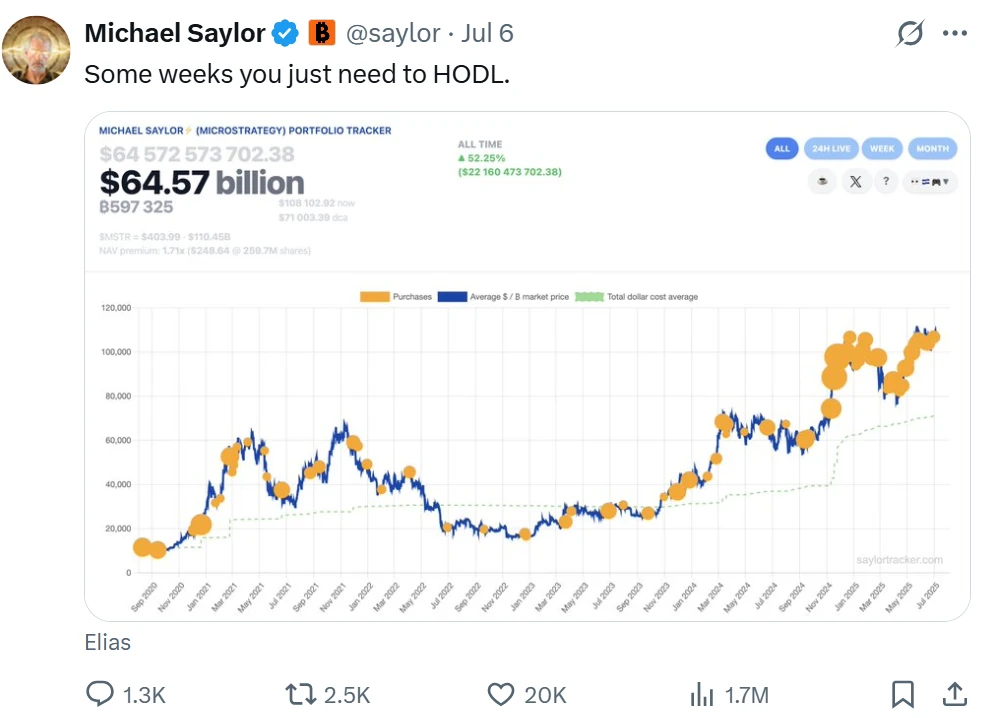
The Weight of Bitcoin Reserves: How Strategy Influences the Market
As of July 8, Strategy's total Bitcoin holdings have reached 597,000 BTC, accounting for 2.84% of the total supply. This not only far surpasses other publicly listed companies but is also 2.3 times the combined holdings of the top 100 listed companies (excluding Strategy).
According to the 8-K filing submitted by Strategy to the U.S. SEC, as of June 30, the digital asset value of Strategy (MSTR.O) was $64.36 billion, with an average cost of $70,982 per coin, and the fair value of Bitcoin appreciated by $14 billion in the second quarter of 2025.
In other words, Strategy is not only a major whale in Bitcoin but also a lever for market price sentiment. Every move by Strategy triggers sensitive points in the market. From the several pauses in purchasing since 2025, almost all have indicated a short-term market correction; will this time be an exception?
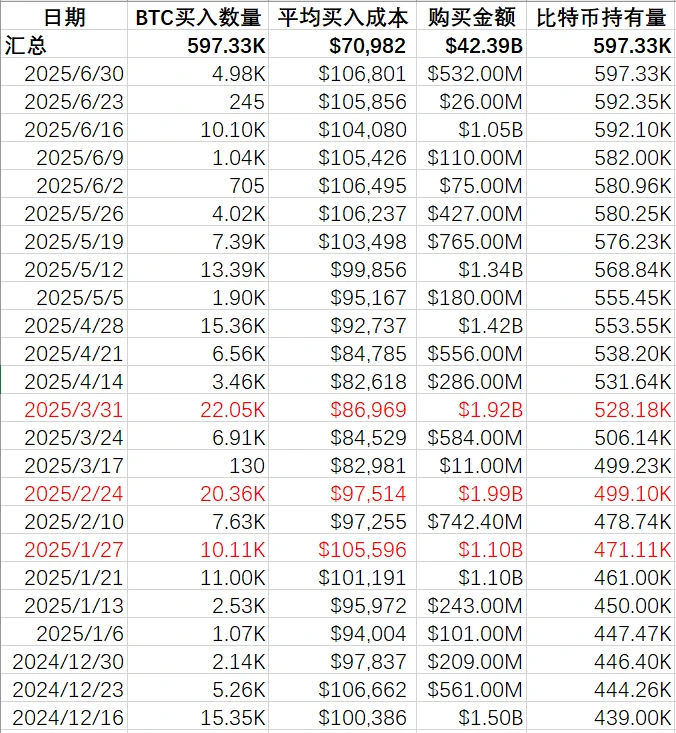
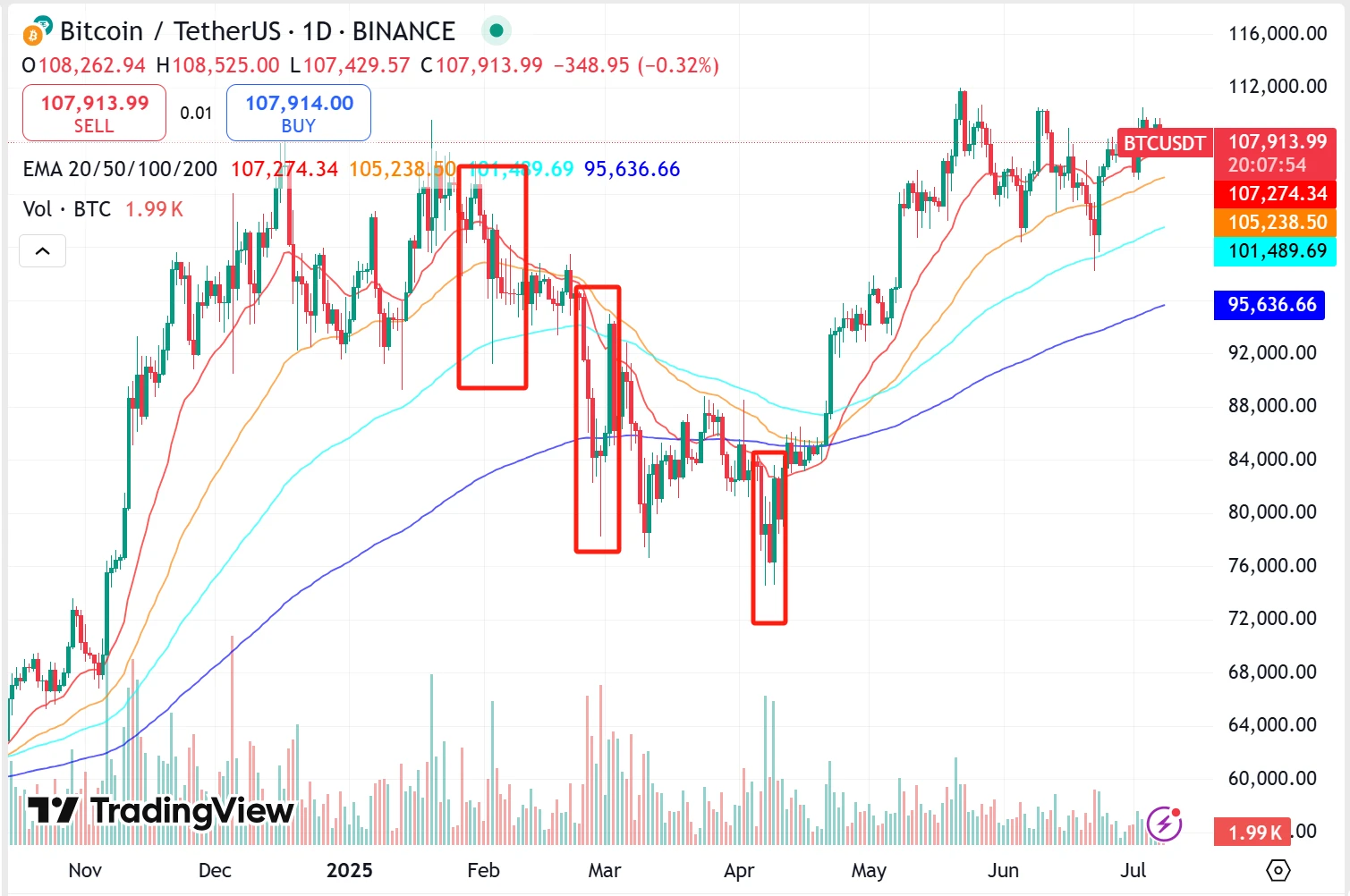
The Correlation Between Strategy's Purchase Pause and Bitcoin Trends
The Fundraising Flywheel: The Capital Game of Preferred Shares
Strategy originally started as a company focused on enterprise analytics software. Since 2020, its core strategy has shifted to using Bitcoin as a primary reserve asset, aiming to hedge against inflation and achieve asset appreciation. Strategy has gained significant notoriety due to its large-scale investments in Bitcoin.
To continue purchasing Bitcoin, Strategy requires substantial capital. Therefore, it has chosen to raise funds through the issuance of preferred shares. Since February 2025, Strategy has issued three types of preferred shares: STRF, STRK, and STRD, each corresponding to different yield mechanisms and risk priorities:
STRF: 10% cumulative dividend, highest priority. If unpaid, dividends will compound at an additional 1% per year, up to a maximum of 18%.
STRK: 8% cumulative dividend, with attached conversion options.
STRD: 10% non-cumulative dividend, lower priority, more for broad distribution to the market.
The core design of this structure is to allow Strategy to continuously leverage new capital without severely diluting the equity of common shareholders, providing ammunition for its ongoing Bitcoin purchases, thus maintaining the "issue shares—buy coins—raise stock price" flywheel loop.
From market performance, MicroStrategy (MSTR) has significantly outperformed Bitcoin itself, especially driven by the recent "crypto stock" craze. STRK and STRF, as earlier issued preferred shares, have also performed exceptionally well, while the later issued STRD has shown impressive potential. In terms of price trends, STRK and STRF have recently performed particularly well, even greatly surpassing MSTR's stock performance.
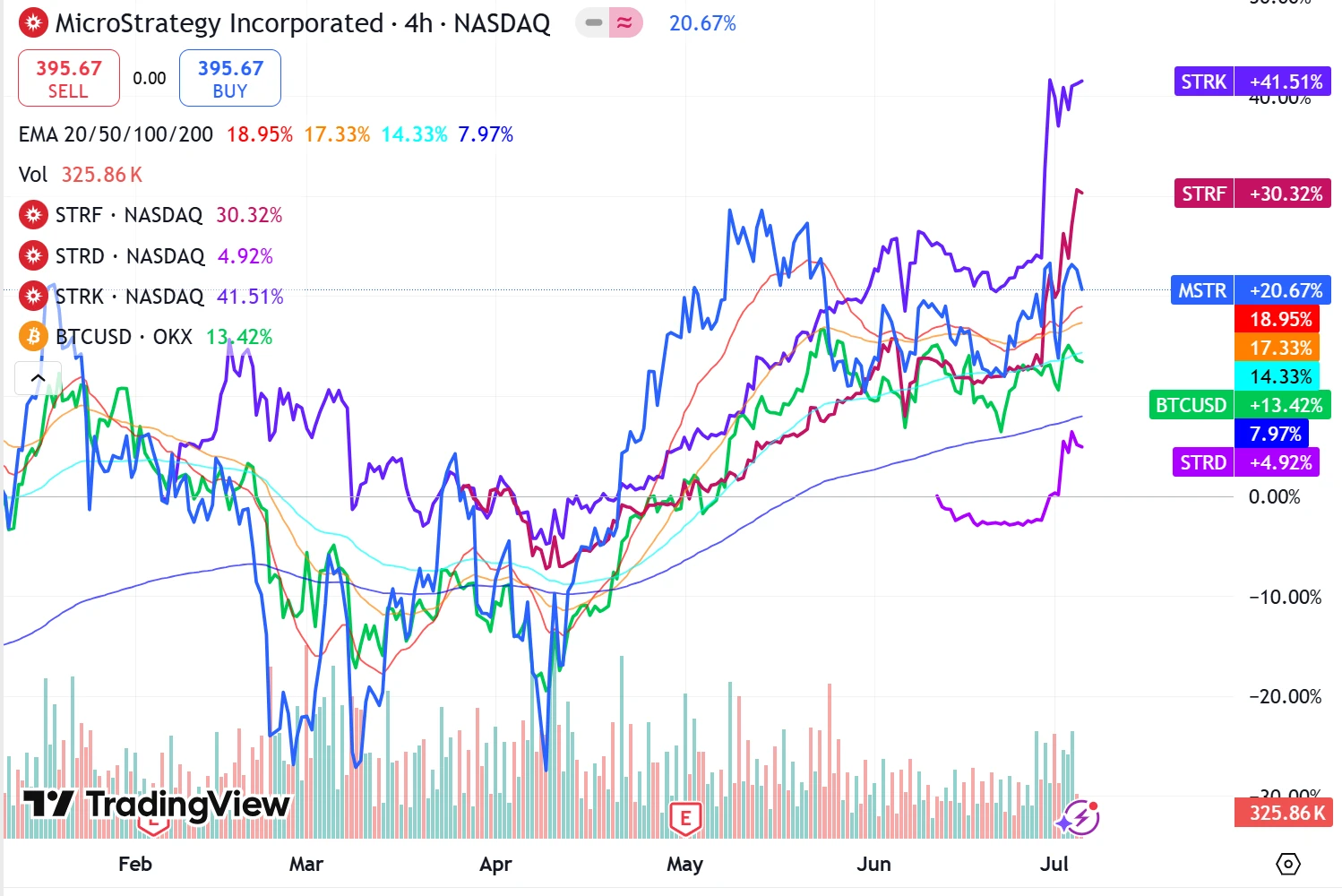
Notably, in March, this preferred share issuance plan attracted the attention of internal executives. According to disclosures from the U.S. Securities and Exchange Commission, several insiders at Strategy purchased its newly launched preferred shares, including the CEO, CFO, and other executives. CEO Phong Le purchased 6,000 preferred shares at $85 each, CFO Andrew Kang bought 1,500 shares, and General Counsel Wei-Ming Shao bought 500 shares. This "self-purchase" behavior serves as a signal and reflects the company's strong expectations for future returns.
On June 5, Strategy announced a public offering of 11,764,700 shares of 10.00% Series A perpetual Stride preferred stock at an issue price of $85 per share, completing the transaction on June 10, raising approximately $980 million. Just today, Strategy announced it has signed a new sales agreement. According to this agreement, it plans to issue STRD shares to raise $4.2 billion and expects to prepare for "on-demand, phased" continuous financing under the ATM plan. This flywheel is spinning faster and faster.
The Other Side of Leverage: Growth Engine, Also a Risk Trigger?
According to Strategy's Q1 2025 financial report released on May 1, it has raised nearly $10 billion through preferred shares, convertible bonds, and common stock ATM issuance, almost all of which has been invested in Bitcoin. This high-leverage operation amplifies the paper gains from Bitcoin's rise but also increases cash flow burdens, especially the annual interest expenses of 8% to 10% from preferred shares.
As of now, MSTR's market capitalization is approximately $112.9 billion, with an enterprise valuation around $120 billion, corresponding to a net asset multiple of 1.7. Although still within a reasonable range, the elasticity of this line depends on two pivot points: first, the sustained strength of Bitcoin prices, and second, the smooth and stable external financing environment.
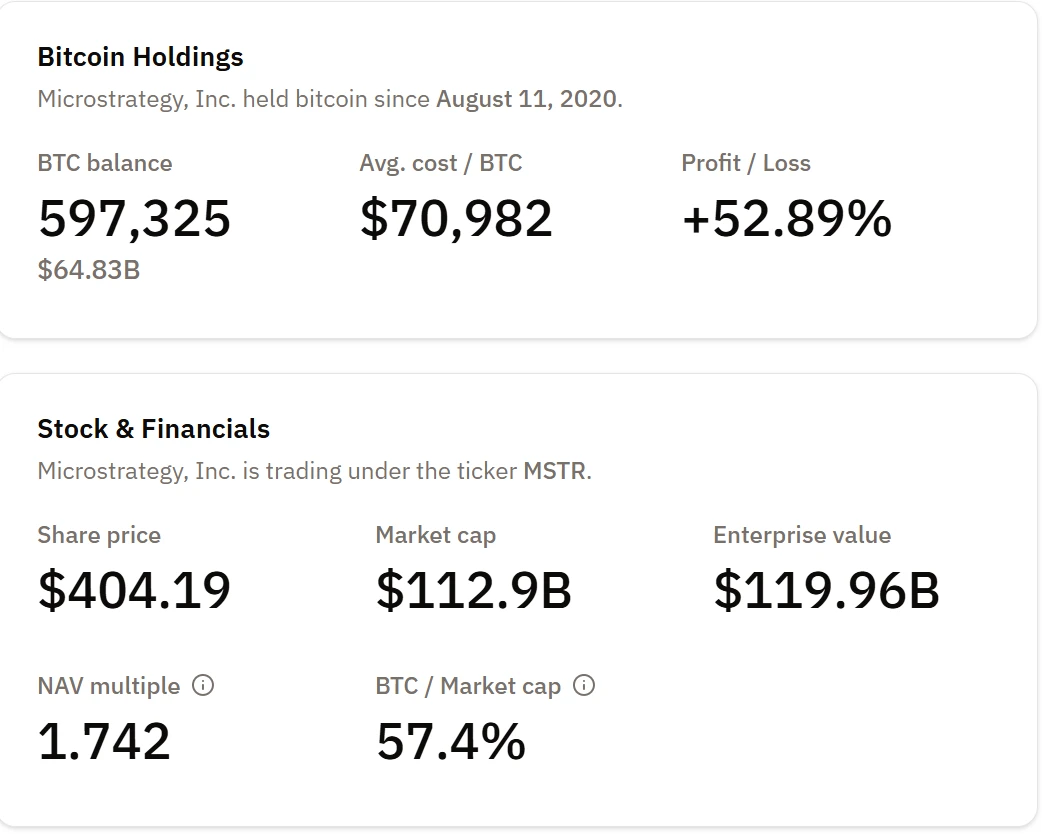
From the revenue side, the company's own "blood generation" ability is weak. According to data provided by @0xChainMind, the company's software business revenue in 2024 was only $463 million, marking the lowest record since 2010.
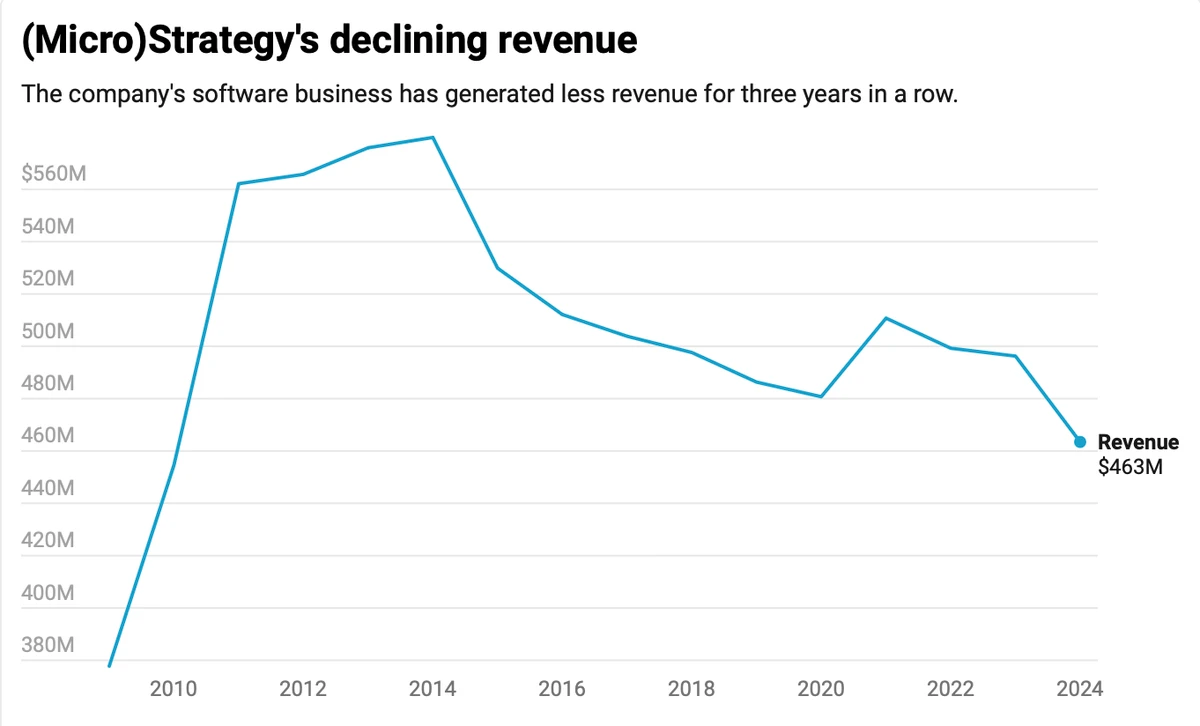
From the Q1 financial report, the company's main business in the first quarter of 2025 totaled $111.1 million in revenue, a 3.6% decrease year-on-year (compared to $115.2 million in Q1 2024). However, subscription service revenue was $37.1 million, a 61.6% increase year-on-year, indicating a successful transformation in cloud services and subscription models, which is a highlight in revenue. If the old impairment model is still used for calculations, operating expenses and losses are approximately $190 million (there is a point of contention here, and Strategy is facing a class-action lawsuit as a result), with cash reserves at $60.3 million. If this data is used for estimation, operating expenses can barely be covered. If the company wants to maintain operations and pay the 8%-10% annual interest on preferred shares (with annual expenses reaching $300 million to $500 million), it must rely on "continuous financing" to keep the flywheel running.
The "Bombshell" Behind the Reports: $5.9 Billion Unrealized Loss, Class Action Lawsuit on the Way
The reason Strategy is facing a class-action lawsuit is that it adopted the new FASB accounting standards (ASU 2023-08) for the first time in Q1 2025. According to the new rules, the company must measure crypto assets at fair value, rather than only recognizing impairments when prices decline. This means that any fluctuations in Bitcoin prices will be reflected in the income statement in real-time and directly.
The result is that in Q1 alone, Strategy disclosed an unrealized loss of $5.9 billion, directly causing MSTR's stock price to plummet by 8% during that quarter.
Worse still, the company has been accused of failing to timely and comprehensively disclose these unrealized loss risks. The well-known New York law firm Pomerantz LLP promptly initiated a class-action lawsuit against Strategy in the Eastern District of Virginia, accusing it of "false and misleading statements" between April 2024 and April 2025, allegedly violating federal securities laws. The case is currently progressing, and investors can apply to join the class action lawsuit before July 15. Strategy has stated it will actively respond but has not predicted the outcome of the case.
This means that Bitcoin prices not only determine the asset value of Strategy but are also determining its legal risks, financing capabilities, and investor confidence.
Voices from the Market
Michael Saylor stated that Strategy has developed a BTC credit model that comprehensively considers loan duration, collateral coverage, BTC price, volatility, and annual yield expectations to generate statistical data on Bitcoin risk and credit spreads. Strategy is promoting the digital transformation of the credit market through its STRK, STRF, and STRD, which means that Strategy's path is no longer just about buying Bitcoin; it resembles the construction of a closed-loop system around the capitalization and financialization of BTC.
A report from venture capital firm Breed pointed out that due to its scale, holdings, and counter-cyclical capabilities, Strategy may become a long-term survivor of the crypto financial model, with a 91% probability of being included in the S&P 500 index by the second quarter of 2025.
However, not everyone is so optimistic. Some analysts have noted that while this flywheel operates smoothly in a bull market, its debt structure, preferred stock interest, and cash flow stability will face severe tests once entering a bear market.
On July 1, TD Cowen reiterated its "buy" rating on Strategy in a research report and maintained its target price of $590 per share. It stated that despite the risks, the premium of Strategy's stock price relative to its net asset value (NAV) of Bitcoin (BTC) is reasonable. The firm noted that Strategy's "equity-to-BTC loop" model allows it to use its stock issuance revenue to purchase more Bitcoin, thereby driving higher stock prices and further Bitcoin purchases, creating a virtuous cycle.
From the current data, Strategy's short-term cash flow can still "barely sustain," and its Bitcoin holdings are the absolute main character on the company's balance sheet. But this is also its biggest risk: its prosperity is almost built on the assumption of stable or rising BTC prices. In a sense, Strategy is no longer a traditional technology company; it resembles a "high-leverage Bitcoin asset management platform" wrapped in a software shell.
免责声明:本文章仅代表作者个人观点,不代表本平台的立场和观点。本文章仅供信息分享,不构成对任何人的任何投资建议。用户与作者之间的任何争议,与本平台无关。如网页中刊载的文章或图片涉及侵权,请提供相关的权利证明和身份证明发送邮件到support@aicoin.com,本平台相关工作人员将会进行核查。



